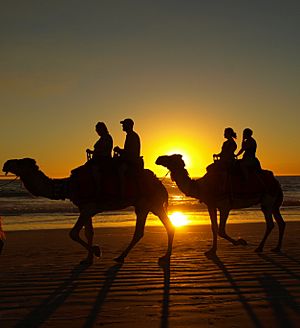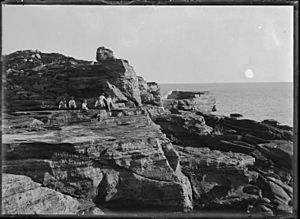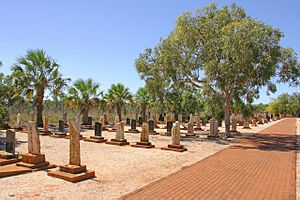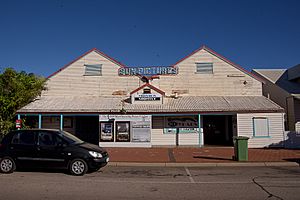Broome, Western Australia facts for kids
Quick facts for kids BroomeWestern Australia |
|||||||||
|---|---|---|---|---|---|---|---|---|---|

Broome jetty
|
|||||||||
| Population | 14,660 (2021 census) | ||||||||
| Established | 1883 | ||||||||
| Postcode(s) | 6725 | ||||||||
| Elevation | 19 m (62 ft) | ||||||||
| Time zone | AWST (UTC+08:00) | ||||||||
| Location | |||||||||
| LGA(s) | Shire of Broome | ||||||||
| State electorate(s) | Kimberley | ||||||||
| Federal Division(s) | Durack | ||||||||
|
|||||||||
Broome, also known as Rubibi by the Yawuru people, is a coastal town in the Kimberley region of Western Australia. It's famous for its history in pearling and as a popular tourist spot. Broome is about 2,046 kilometers (1,271 miles) north of Perth. In 2021, about 14,660 people lived there, making it the biggest town in the Kimberley region.
Contents
Exploring Broome's Geography
Broome is located on the tropical Kimberley coast of Western Australia. It sits right on the edge of the Indian Ocean.
Roebuck Bay: A Natural Wonder
Broome is on a peninsula, which means it has water on two sides! On the eastern side, you'll find the beautiful waters of Roebuck Bay. This bay stretches from the main jetty all the way to Sandy Point.
Town Beach is a popular part of Roebuck Bay's shoreline. It's famous for a special event called the 'Staircase to the Moon'. This happens when the tide goes out and the moon rises, creating a stunning reflection that looks like a staircase reaching to the moon. On these nights, you can also enjoy a fun food and craft market at Town Beach.
Roebuck Bay is super important for millions of waders, also known as shorebirds. These birds travel huge distances from northern Asia every year. They stop in the bay to feed on the wide mudflats and rest on the red sand beaches. You can see the most birds in summer, but many younger birds stay all year. The Broome Bird Observatory was set up in 1988 to study these birds, protect them, and teach people about them.
Close to Broome, in the mangroves near Streeter's Jetty, lives a large colony of about 50,000 megabats. These bats, including black flying foxes and little red flying foxes, chatter loudly before flying out at sunset. They play a vital role in nature by helping to pollinate flowers and spread seeds for native plants.
Cable Beach: White Sands and Sunsets
Cable Beach gets its name from an old undersea telegraph cable that connected Java to Australia right here. It's about 7 kilometers (4.3 miles) from town. This beach is incredibly long, stretching for 22.5 kilometers (14 miles) with soft white sand. The tides here can be very big, sometimes rising over 9 meters (30 feet)! Next to Cable Beach, you'll find Minyirr Park, a coastal reserve managed by the Shire of Broome and the Yawuru people.
Broome's Rich History
The Yawuru People
Broome is built on the traditional lands of the Yawuru people, who have lived here for thousands of years.
Early European Settlement
Many people think William Dampier was the first European to visit Broome in 1688, but he only explored areas further north. In 1883, John Forrest chose the spot for the town. It was named after Sir Frederick Broome, who was the Governor of Western Australia from 1883 to 1889.
The 1880s marked the beginning of Broome's pearling industry. Pearl diving was a very tough job, often done by people from Japan and other Asian countries. This mix of cultures made Broome a unique place. Until the 1970s, different groups of people often lived separately.
In 1889, an undersea telegraph cable was laid from Broome to Java, connecting to England. This is why the beach where it landed is called Cable Beach.
World War II Air Attacks
Broome was attacked by Japanese aircraft at least four times during World War II. The most serious attack happened on March 3, 1942. Many people, mostly refugees from the Dutch East Indies, lost their lives. Twenty-two aircraft were destroyed, and you can still see the remains of some of them in the harbor at low tide.
Dinosaur Footprints and Sister Cities
Amazing dinosaur footprints were found at Gantheaume Point in the 1960s. These tracks are about 130 million years old! You can only see them when the tide is very low.
In 1981, Broome became a sister city with Taiji, Japan. This was because of the strong historical ties between the two towns, especially through the pearling industry.
Protecting the Kimberley Coast
In 2012, the Broome community led a big campaign to stop a plan to build an industrial gas hub near James Price Point, just outside Broome. Many famous musicians and environmentalists supported this campaign. One important reason for the protest was to protect the amazing 'dinosaur highway' – a long stretch of dinosaur tracks found along the coast near Broome.
Ancient Dinosaur Footprints
Fossilized dinosaur footprints, including those from a huge dinosaur called Megalosauropus broomensis, are found about 30 meters (98 feet) out to sea at Gantheaume Point. These tracks are from the early Cretaceous period. You can only see them when the tide is very low.
Some of these tracks are thought to be the largest dinosaur footprints ever found, measuring over 1.7 meters (5.6 feet) long! Scientists believe the dinosaur that made these tracks might have been 7 to 8 meters (23 to 26 feet) tall at its hip.
Broome's Pearling Industry
The town's history is deeply connected to the pearling industry. It started in the 1880s with people harvesting oysters for their shiny inner shell, called mother of pearl. Today, Broome is known for its large cultured pearl farms.
In the early days, some Indigenous people, especially women and girls, were forced to dive for pearls. This was very dangerous, and many suffered. Laws were later made to protect them and stop women from being forced to dive.
By 1910, Broome was one of the world's top pearl producers. About 3,500 of the town's 5,000 residents worked in the pearling industry.
Many people from Asia, especially Japan, became skilled pearl divers. They played a huge part in Broome's community. Pearling was a risky job, and many divers lost their lives. The town's Japanese cemetery is the resting place for 919 Japanese divers.
Every year, Broome celebrates the different cultures that came together because of the pearling industry. This is done through an annual festival called Shinju Matsuri, which means "festival of the pearl" in Japanese.
Broome's Population
In 2021, Broome had 14,660 people.
- About 23.4% of the population were Aboriginal and Torres Strait Islander people.
- 70.6% of people were born in Australia. Other common birthplaces included England (2.9%), New Zealand (1.9%), and the Philippines (1.5%).
- Most people (74.1%) spoke only English at home.
- For religion, 47.0% said they had no religion, and 21.4% were Catholic.
Broome's Climate and Seasons
Broome has a hot, semi-arid climate. This means it's a bit too dry to be a tropical savanna climate. Like most places in tropical Australia, it has two main seasons: a dry season and a wet season.
The dry season lasts from April to November. Most days are clear and sunny, with temperatures around 30°C (86°F). The wet season is from December to March. Temperatures are hotter, around 35°C (95°F), with heavy tropical rain and high humidity. Broome gets about 615.1 mm (24.2 inches) of rain each year, with 75% of it falling from January to March.
The local Yawuru people have their own calendar with six seasons, which helps them understand the changes in weather and nature:
| Name | Month(s) | Characteristics |
|---|---|---|
| Man-gala | December–March | Wet season with strong winds and monsoon rains. |
| Marrul | April | The "let-down" from the wet season, with no wind, high tides, and hot weather. |
| Wirralburu | May | Dry season with no rain, hot days, and cool nights. |
| Barrgana | June–August | Cold season with some fog and dry winds. |
| Wirlburu | September | The "warming" season, with days and nights getting hotter. |
| Laja | October–November | The "buildup" to the wet season, hot and humid. |
Broome can experience tropical cyclones. These, along with summer thunderstorms, make the rainfall very unpredictable. For example, in January 1922, Broome received only 2.8 mm (0.11 inches) of rain, but in January 2018, it got 945.4 mm (37.2 inches)! It never gets frost, but temperatures can drop to 3.3°C (37.9°F) in the cooler months.
The sea temperature is usually warm, from 24.7°C (76.5°F) in July and August to 30.2°C (86.4°F) in March.
| Climate data for Broome Airport | |||||||||||||
|---|---|---|---|---|---|---|---|---|---|---|---|---|---|
| Month | Jan | Feb | Mar | Apr | May | Jun | Jul | Aug | Sep | Oct | Nov | Dec | Year |
| Record high °C (°F) | 44.1 (111.4) |
42.7 (108.9) |
42.2 (108.0) |
41.0 (105.8) |
38.7 (101.7) |
36.2 (97.2) |
36.0 (96.8) |
37.8 (100.0) |
41.3 (106.3) |
43.4 (110.1) |
44.6 (112.3) |
44.8 (112.6) |
44.8 (112.6) |
| Mean daily maximum °C (°F) | 33.3 (91.9) |
32.9 (91.2) |
34.0 (93.2) |
34.3 (93.7) |
31.6 (88.9) |
29.2 (84.6) |
28.9 (84.0) |
30.3 (86.5) |
31.8 (89.2) |
33.0 (91.4) |
33.7 (92.7) |
33.9 (93.0) |
32.2 (90.0) |
| Daily mean °C (°F) | 29.8 (85.6) |
29.5 (85.1) |
29.8 (85.6) |
28.5 (83.3) |
25.0 (77.0) |
22.2 (72.0) |
21.3 (70.3) |
22.6 (72.7) |
25.2 (77.4) |
27.8 (82.0) |
29.5 (85.1) |
30.2 (86.4) |
26.8 (80.2) |
| Mean daily minimum °C (°F) | 26.3 (79.3) |
26.0 (78.8) |
25.5 (77.9) |
22.7 (72.9) |
18.3 (64.9) |
15.2 (59.4) |
13.7 (56.7) |
14.9 (58.8) |
18.5 (65.3) |
22.5 (72.5) |
25.2 (77.4) |
26.5 (79.7) |
21.3 (70.3) |
| Record low °C (°F) | 19.0 (66.2) |
15.2 (59.4) |
16.0 (60.8) |
12.6 (54.7) |
7.7 (45.9) |
5.2 (41.4) |
3.3 (37.9) |
3.8 (38.8) |
8.9 (48.0) |
13.3 (55.9) |
16.7 (62.1) |
17.4 (63.3) |
3.3 (37.9) |
| Average rainfall mm (inches) | 191.5 (7.54) |
183.0 (7.20) |
98.9 (3.89) |
25.5 (1.00) |
26.9 (1.06) |
18.9 (0.74) |
6.8 (0.27) |
2.2 (0.09) |
1.4 (0.06) |
1.4 (0.06) |
9.1 (0.36) |
63.3 (2.49) |
628.9 (24.76) |
| Average rainy days (≥ 0.2 mm) | 11.7 | 11.5 | 7.9 | 2.6 | 2.4 | 1.8 | 1.3 | 1.0 | 0.9 | 0.6 | 1.3 | 5.5 | 48.5 |
| Average afternoon relative humidity (%) | 65 | 67 | 60 | 45 | 38 | 36 | 33 | 35 | 45 | 54 | 57 | 61 | 50 |
| Average dew point °C (°F) | 24 (75) |
25 (77) |
24 (75) |
20 (68) |
14 (57) |
11 (52) |
9 (48) |
11 (52) |
16 (61) |
20 (68) |
22 (72) |
24 (75) |
18 (65) |
| Mean monthly sunshine hours | 257.3 | 212.8 | 263.5 | 294.0 | 291.4 | 282.0 | 306.9 | 325.5 | 312.0 | 337.9 | 336.0 | 291.4 | 3,510.7 |
| Source: Time and Date: dew points (1985-2015) | |||||||||||||
Schools in Broome
Broome has six schools for students. Five of them are government schools: Broome Primary School, Broome North Primary School, Cable Beach Primary School, Roebuck Primary School, and Broome Senior High School. There is also St Mary's College, which is a Catholic school for students from kindergarten to Year 12.
Sports and Fun Activities
Broome offers many ways to stay active! It has a lawn bowling club and a golf club. If you love fishing, Broome is known as one of the best places in the world to catch sailfish.
For football fans, four soccer clubs play in the local Broome Football Association's BLiga competition during the dry season. These teams are FC Meatworks, Pearlers, Racing G, and Broome Town. They have both men's and women's teams.
There are also four Australian rules clubs: Broome Bulls, Broome Saints, Broome Towns, and Cable Beach. They all play in the West Kimberley District League at Haynes Oval.
Culture and Entertainment
Broome is home to the Sun Picture Garden, which is the oldest operating open-air cinema in the world! Imagine watching a movie under the stars.
Marrugeku is a special dance company. It's led by Dalisa Pigram, a choreographer and dancer, and Rachael Swain, a director. This company brings together Indigenous and non-Indigenous Australians to create amazing new dance shows. They work from two places: Broome and Carriageworks in Sydney.
Getting Around Broome
Broome International Airport is the main airport for northwestern Western Australia. It's often called the "tourism gateway" to famous places like the Horizontal Falls and the entire Kimberley region.
From 1898 until the 1960s, the Broome Tramway was used to carry goods between Mangrove Point and the town center.
News and Media
Since 1992, Broome has had its own local community newspaper, the Broome Advertiser, which comes out every Thursday. Before that, there was The Nor-West Echo from 1912 to 1930.
You can watch several TV stations in Broome, including GWN7, WIN9, WDT10, ABC, SBS, and Goolarri Media. GWN7 even has a local news team in Broome that covers news for the area.
Crocodile Park
The Malcolm Douglas Crocodile Park is about 16 kilometers (10 miles) from Broome. It was started in 1983 by Malcolm Douglas, who made wildlife documentaries. The park is home to 30 adult crocodiles that were caught in the wild because they were a danger to people. One famous crocodile there is Fatso, who once bit a man who climbed into his enclosure!
See also
 In Spanish: Broome para niños
In Spanish: Broome para niños







